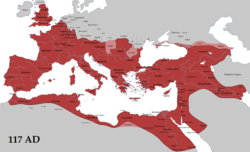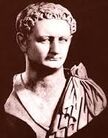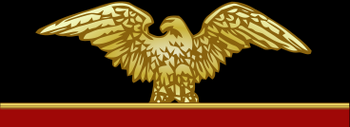The Roman Empire or commonly known as the SPQR, ruled from the city of Rome, was a large empire ruled by an emperor who had supreme power, who, at least at the beginning, officially ruled by "will of the Senate".
During its height, the Pax Romana—or Roman Peace—ruled roughly a quarter of the ancient world's population, and its territory stretched over an amount of land comparable to that of the modern day United States. The Empire followed on from the Roman Republic and lasted until 286 AD, when it was divided into the Eastern Roman Empire and the Western Roman Empire.
Chronology[]
Here is a list of Roman Kingdoms and Empires that existed throughout history:
Roman Kingdom (-753--509)
Roman Republic (-509--27)
Roman Empire (-27-395)
Western Roman Empire (395-476)
Kingdom of Altava/Mauro-Roman Kingdom (477-708)
Kingdom of Soissons/Realm of Syagirius (457-486)
Kingdom of Dalmatia/Realm of Julius Nepos (476-480)
Eastern Roman Empire/Byzantine Empire (395-1204) (1261-1453)
Latin Empire (1204-1261)
Empire of Nicaea (1204-1261)
Principality of Theodoro (~1330-1475)
Empire of Trebizond (1204-1461)
Despotate of Epirus (1204-1479)
History[]

The Roman Empire at its height under Emperor Trajan
The Julio-Claudian Dynasty[]

Augustus, the first emperor of the Roman Empire
After decades of civil war amongst dictators and triumvirates, Octavian of the former Second Triumvirate defeated his rival Mark Antony at the Battle of Actium and over the course of a few more years, gradually persuaded the Senate to grant him the status of Rome's first emperor. Octavian then renamed himself Augustus and led Rome with fair success.
Intrigues over his succession proved common during Augustus's reign; Mark Antony's sons, and those of Augustus's old friend, Marcus Agrippa, both had claims to the throne. Neither, however, succeeded in claiming it. For the son of Augustus's wife, Julia, had been the one to seize it with the help of his mother's playing hand. When Augustus mysteriously died in 14 AD, his adopted son, Tiberius, came to the throne. Tiberius's reign, however, was marked by tyranny and persecution, as well as ineffective administration. More disappointing still was when Tiberius's successor, Caligula, came to throne after the former emperor's death in 37 AD. Although Caligula's rule proved short, his turbulent rule still stuns history to this day. He even humiliated the Senate to the point where he threatened to make a horse the consul of Rome. His mental health in particular, proved again and again to be questionable. Ultimately, Caligula and most of his family were assassinated in 41 AD. Luckily, Caligula's successor and only spared family member, Claudius, proved to be a capable emperor, conquering Britain in 43 AD. Like Augustus, however, Claudius was vulnerable to an unstable succession; this being realized in 54 AD, when he was succeeded by yet another tyrant known as Nero.
Nero commonly invested in extravagant projects and forced Roman citizens to listen to him playing his lyre. So infamous were his lyre concerts that a myth came about that spoke of Nero playing his lyre while Rome burned. Although this wasn't entirely true, it was fact that he had been ruling when Rome suffered its Great Fire in 64 AD. After having built his lavish palace with ruins of the fire, Rome's discontent for him at last exploded in 68 AD, when he, under pressure, committed suicide. With no clear successor, Rome's generals made quick opportunity for the emperor's Throne for themselves.
The Year of the Four Emperors and the Flavian Dynasty[]

The Flavian Dynasty/Family
Four emperors arose to power in the one year of 69 AD, with this short time period becoming known as the Year of the Four Emperors. The first three, Galba, Otho, and Vitellius, were all deposed or killed in conspiracies between each other. The fourth one, Vespasian, succeeded in establishing a solid, long-lasting dynasty. His rule saw the beginning of the construction of the Colosseum, as well as effective financial reforms, and the conquest of Judea. When Vespasian died in 79 AD, his renowned general and son, Titus, succeeded him. In the two years Titus was emperor, he offered relief to the victims of the volcanic disaster at Pompeii and completed the Colosseum. Titus's natural death in 81 AD brought his half-brother, Domitian, to the head of the Empire. Domitian continued financial reforms and waged numerous wars, and expanded the vast majority of the Empire's frontier bulwarks. Seeing himself as an enlightened despot, Domitian did also come

Domitian
to consult an oracle on what he thought would be a glorious fate for himself. Instead, he was told he would be assassinated one day. Now leery and slightly paranoid, Domitian pursued a more totalitarian approach and propagated a good public and military name for himself. His far less kindly treatment, however, towards political and senate rivals made him viewed as being tyrannical. As a result, this publicly charismatic leader met his true death to the hands of aristocratic distaste in 96 AD. The Senate then took charge and appointed Domitian's former advisor, Nerva, to the position of Emperor.
The Adopted Emperors[]
The Severan Dynasty[]
The Military Emperors[]
Barracks emperors were especially common in the period from 235 through 284, during the Crisis of the Third Century. There were approximately fourteen barracks emperors in 33 years, producing an average reign of a little over two years apiece. The resulting instability in the imperial office and the near constant state of civil war and insurrection threatened to destroy the Roman Empire from within and left it vulnerable to attack from without.
The Tetrachy[]
The Tetrarchy is the term adopted to describe the system of government of the ancient Roman Empire instituted by Roman Emperor Diocletian in 293, marking the end of the Crisis of the Third Century and the recovery of the Roman Empire. This tetrarchy lasted until c. 313, when mutually destructive civil wars eliminated most of the claimants to power, leaving Constantine in control of the western half of the empire, and Licinius in control of the eastern half.
The Constantinian Dynasty[]
Constantinian dynasty is an informal name for the ruling family of the Roman Empire. It is named after its most famous member, Constantine the Great who became the sole ruler of the empire in 324. The dynasty is also called Neo-Flavian because every Constantinian emperor bore the name Flavius.

The Valentinian Dynasty[]
The Valentinian Dynasty consisted of four emperors, who ruled the Western Roman Empire from 364 to 392 and the Eastern Roman Empire from 364 to 378.

The Theodosian Dynasty[]
The Theodosian dynasty was a Roman family that rose to eminence in the waning days of the Roman Empire.
Its founding father was Flavius Theodosius (often referred to as Count Theodosius), a great general who had saved Britannia from the Great Conspiracy. His son, Flavius Theodosius was made emperor of the Eastern Roman Empire in 379, and briefly reunited the Roman Empire 394–395 by defeating the usurper Eugenius. Theodosius I was succeeded by his sons Honorius in the West and Arcadius in the East. The House of Theodosius was related to the Valentinian Dynasty by marriage, since Theodosius I had married Galla, a daughter of Valentinian I. Their daughter was Galla Placidia. The last emperor in the West belonging to the dynasty was Galla Placidia's son Valentinian III. The last emperor of the dynasty in the East was Theodosius II, the son of Arcadius.
Rome's weakening and dramatic end[]
|
History of Ancient Rome |
|---|
|
Roman Kingdom | Roman Republic | Roman Empire |
|
Western Roman Empire | Byzantine (Eastern) Empire |
|
Realm of Sygirius | Kingdom of Altava | Realm of Julius Neppos | Latin Kingdom | Kingdom of Nicea | Bosporan Kingdom | Principality of Theodosia | Depotate of Epiros |
|
Frankish Empire & Holy Roman Empire |
| History of the Roman Empire |
|---|
| History: The End of the Roman Republic (60 BCE - 27 BCE) | Augustan Age (27 BCE - CE 14) | Julio-Claudian Age (14 - 68) | Year of the Four Emperors (68 - 69) | Flavian Age (69 - 96) / Nervan-Antonine Age (96 - 193) | Severan Dynasty (193 - 235) | Crisis of the Third Century (235 - 268) | see also the Gallic Empire| Illyrian Emperors (268 - 284) | Tetrarchical Age (284 - 308) | Constantinian Age (307 - 364) | see also the Britannic Empire | Valentinian Age (364 - 388) | Theodosian Dynasty (379 - 395) | in 395, Roman Empire permanently divided into Western Roman Empire and Eastern Roman Empire
severan |




